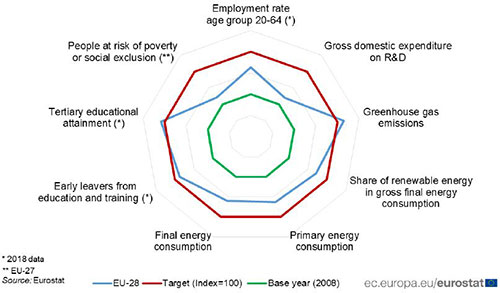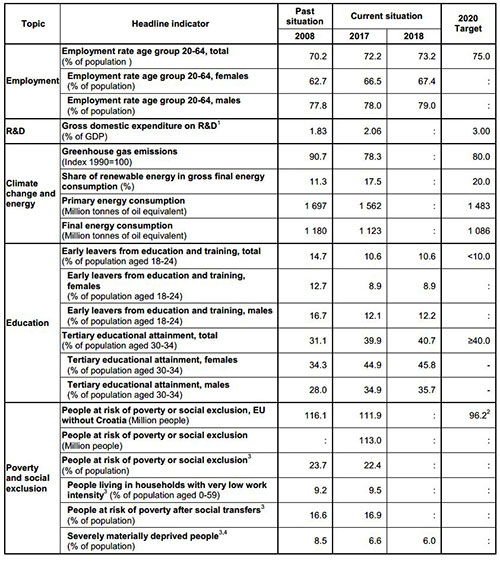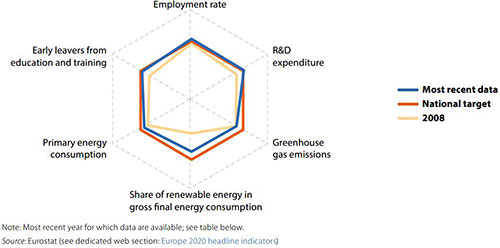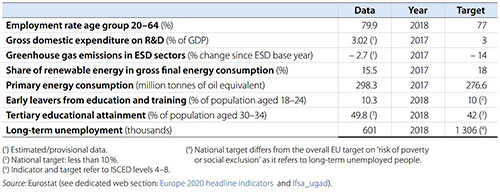Europa-2020-targets: How is the EU and Germany progressing?
- Date
- 2020.01.08
The Europe 2020 strategy is the EU's agenda for jobs and growth for the current decade. With the publication "Smarter, greener, more inclusive?" Eurostat provides information on latest statistics each year useful to monitor the progress towards the targets of the strategy. Now the 2019 edition has been issued.
As a main objective, the strategy strives to deliver high levels of employment, productivity and social cohesion in the Member States, while reducing the impact on the natural environment. To reach this objective, the EU has adopted targets to be reached by 2020 in five areas:
- employment,
- research & development (R&D) and innovation,
- climate change and energy,
- education and
- poverty and social exclusion.
These have been translated into national targets in order to reflect the situation and possibilities of each Member State to contribute to the common goal. A set of nine headline indicators and additional sub-indicators, compiled by Eurostat, give an overview of how close the EU is to its overall targets.The European Social Fund, with its operational programme, makes a valuable contribution to achieving the objectives.
The publication "Smarter, greener, more inclusive?" aims to shed light on the trends in the headline indicators over the past years and helps understand the factors behind the changes observed so far.
A complete picture of trends in the Europe 2020 headline indicators
The radar chart below presents the current situation of the EU by showing the progress made since 2008 and the distance still to cover towards the Europe 2020 key targets.
Europe 2020 headline indicators: target values and progress since 2008

The employment target is within reach, if it continues to grow at the current pace. The EU has already met the tertiary education target and is approaching the target of early leavers from education and training. Europe has made substantial progress in the area of climate change and energy and is on track with the Europe 2020 greenhouse gas, renewable energy and energy efficiency targets. Investment in R&D as well as risk of poverty and social exclusion remain at a distance from targets.
Europe 2020 strategy headline indicators for the European Union

Country Profile Germany
Long-term unemployment, used in Germany as a national target in the area of poverty and social exclusion, went down by 63.0 % between 2008 and 2018. This allowed the country to significantly exceed its target of reducing long-term unemployment by 20 % by 2020. Germany had already met its 77 % employment target in 2013 and continued to increase its employment rate until 2018. In 2018, Germany also surpassed its national target on tertiary educational attainment by 7.8 percentage points, with 49.8 % of 30- to 34-year-olds having completed post-secondary education or equivalent. Germany’s national target differs from that of other Member States because it includes post-secondary non-tertiary education (ISCED level 4) in addition to ISCED levels 5 to 8. In addition, Germany was only 0.3 percentage points away from meeting its target for early leavers from education and training in 2018. In 2017, the country surpassed its national targets for R&D expenditure by 0.2 percentage points. Between 2008 and 2017, Germany reduced the distance to its national targets on primary energy consumption and renewable energy by half but remained further from its energy efficiency target than any other Member State. In addition, a gap of 11.3 percentage points to its target on Greenhouse gas emissions in ESD sectors persisted in 2017.
Change since 2008 in relation to national targets

National Europe 2020 indicators: most recent data and targets
